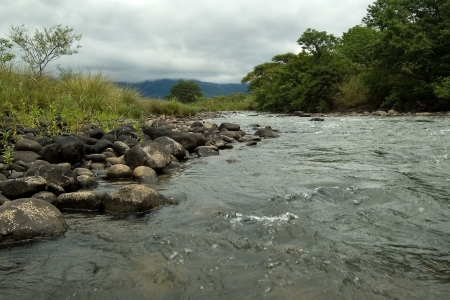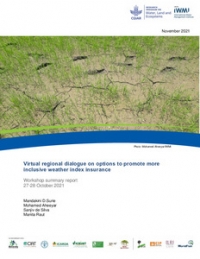Millions of smallholder farmers are struggling under immediate climate change impacts and need respite, now.
Every week, new reports announce the increasingly dire state of the global climate emergency. UN experts recently warned that global temperatures could rise by almost 4°C by the end of the century. This foreboding outlook was announced on the heels of no less than 11,000 scientists trying, once again, to shock the world into action by warning of the “untold suffering” to come from mounting climate impacts.
Global leaders and experts are now finishing up the UN climate meetings (COP25) in Madrid, charting next steps for averting climate disaster. But after a quarter century of talks, we are troubled that so little has changed for those most affected by adverse climate change impacts – vulnerable smallholder farmers and communities. And we get the sense we are not alone in this concern.
Despite explicit resilience objectives in the Sustainable Development Goals and national climate mitigation plans (NDCs), farmers are becoming more, not less, vulnerable. They contend with climate-driven impacts such as droughts, heat waves, floods and cyclones. These amplify smallholders’ many other production, market, institutional and financial risks.
But what if farmers and other guardians of nature could become agents of change for climate resilience?
Resistance, recovery, robustness
The lack of progress on climate resilience is due, in part, to confusing and contradictory definitions. Highly varying contexts have further muddled those waters. So we have developed practical guidance on what guardians of nature can do to reduce their own vulnerability and contribute to broader solutions.
In a recently published paper, we propose a list of seven questions that every irrigation manager, watershed association or agricultural cooperative – and even farmers themselves – can use to increase the resilience of the natural system they are so closely connected to. The answers can help change the ways they grow crops, tend livestock, manage water, cultivate soil and interact with natural systems. The results can be stronger climate resilience, more sustainable food production, and improved livelihoods and human health.
Our starting point is the ‘3 Rs’ of resilience. First, resistance: a system retaining functions following an adverse event, such as a drought. Second, recovery: the system returning to previous performance within a certain recovery time. Third, robustness: the likelihood that the system bounces back to basic functionality. Beyond this point, everything depends on context.
Seven questions to achieve resilience
Let’s look at an example. Say we have in mind a cooperative of farmers that uses solar-powered pumps to irrigate their fields. They pump from a groundwater aquifer, which not only delivers water to their farms, but also to other farmers, for domestic uses, lakes and streams. Now, by switching from diesel pumps to solar-powered ones, this cooperative has already taken one step toward reducing GHG emissions and mitigating climate change. But, if these farmers live in an area with drought or worsening prolonged dry spells – like in Mozambique, Jordan or many other places around the globe – then they also need more immediate relief. It would make sense for these farmers to increase resilience to drought. But how?
Seven resilience questions
|
Well, answering each of the seven questions brings us closer to managing resilience. Three of the seven (#1, #2 and #5) help get the basics down: What is being managed, for whom and to handle what challenge? It’s groundwater, in this case, managed for farmers and other water users in response to droughts.
Then come questions related to metrics (#3 and #4): What are the key metrics for system performance? In this case, they likely include groundwater quantity and quality, extraction costs, food production and profitability of irrigated farming, but also the availability of groundwater for other users and uses. What key metrics would ensure system viability under drought? This might include maximum monthly or seasonal changes in groundwater tables, minimum aquifer recharge rates and minimum net returns for the cooperative.
Now that the cooperative has identified resilience metrics, they can answer key question #6: How do we measure the ‘3 Rs’: resistance, recover and robustness?
Resistance could be measured as the profit margin of the cooperative once drought hits. That is, would these farmers be able to withstand the shock? For example could they buy water from another resource, or sell solar power instead of irrigating and make a profit? Recovery could be assessed by measuring how long it takes them to return their farming activities to pre-drought levels. Robustness, finally, assesses the likelihood the aquifer will recover from various types of drought, which might depend on the aquifer’s size and other factors.
They then can, finally, tackle the very crucial question #7: What are the expected net benefits of changes made to the system for improved resilience?
For example, what if an alternative water resource was made available, through a pipe bringing in surface water flows or rooftop water harvesting for domestic users? What if the cooperative changed its irrigation schedule to use less water during droughts? Or, what if they invested in better groundwater governance so that water was more fairly shared and judiciously used during droughts? Answering these questions, this cooperative and its neighbors can then calculate if these management practices would pay off given drought and other risks.
Lifting together
Of course resilience, in practice, is always context dependent. Answering the questions above is a complex undertaking, but farmers and other guardians of nature have little choice but to adapt their actions to their own circumstances. With these seven questions in hand, they have a better chance at assessing risks and finding solutions, thus boosting the resilience of their natural systems.
Still, global actions are needed too. It cannot be farmers’ responsibility alone to solve the climate emergency. Policy measures, political pressure and commitments from the private sector are critical too. But enlisting guardians of nature – and supporting them financially or in kind – to join forces in lifting a considerable part of the climate burden can make an important contribution to improving climate resilience. This could be an important step to prevent or postpone the untold suffering now looming on the horizon.
Also published on IFPRI.








/index.jpg?itok=EzuBHOXY&c=feafd7f5ab7d60c363652d23929d0aee)








